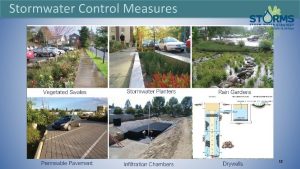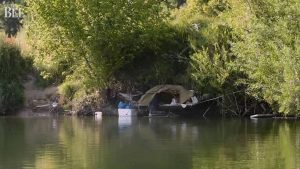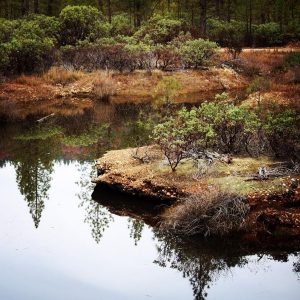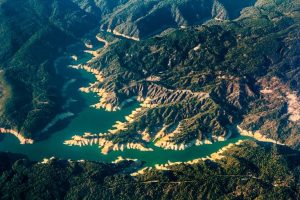 From Public Policy Institute of California – An Interview with Tim Ramirez of the Central Valley Flood Protection Board – TIM RAMIREZ: The valley has always flooded, especially in spring when snow melts in the high Sierra. Before it was developed, the landscape was often an inland sea in the spring. Now that many more people live there, it’s harder to minimize risk. The flood management system in the valley was envisioned 150 years ago, and in a lot of ways it continues to work. But the climate is changing with more rain and less snow, requiring an update. That’s where the Central Valley Flood Protection Plan comes in. The plan is meant to not only protect people but also to help restore river ecosystems. (more)
From Public Policy Institute of California – An Interview with Tim Ramirez of the Central Valley Flood Protection Board – TIM RAMIREZ: The valley has always flooded, especially in spring when snow melts in the high Sierra. Before it was developed, the landscape was often an inland sea in the spring. Now that many more people live there, it’s harder to minimize risk. The flood management system in the valley was envisioned 150 years ago, and in a lot of ways it continues to work. But the climate is changing with more rain and less snow, requiring an update. That’s where the Central Valley Flood Protection Plan comes in. The plan is meant to not only protect people but also to help restore river ecosystems. (more)
 From Water Education Foundation’s Western Water Notebook – Many of California’s watersheds are notoriously flashy – swerving from below-average flows to jarring flood conditions in quick order. The state needs all the water it can get from storms, but current flood management guidelines are strict and unyielding, requiring reservoirs to dump water each winter to make space for flood flows that may not come. However, new tools and operating methods are emerging that could lead the way to a redefined system that improves both water supply and flood protection capabilities. (more)
From Water Education Foundation’s Western Water Notebook – Many of California’s watersheds are notoriously flashy – swerving from below-average flows to jarring flood conditions in quick order. The state needs all the water it can get from storms, but current flood management guidelines are strict and unyielding, requiring reservoirs to dump water each winter to make space for flood flows that may not come. However, new tools and operating methods are emerging that could lead the way to a redefined system that improves both water supply and flood protection capabilities. (more)
The Central Valley Flood Protection Board (Board) is accepting requests from local agencies under Public Law 84-99 (PL 84-99) to provide assistance for repairs to federal flood control project features damaged by the recent flood events (February 13, 2019 to February 15, 2019 and February 24, 2019 to March 1, 2019). The repair assistance applies to Butte, Tehama, Shasta, Colusa, Glenn, and Napa Counties, however if your system is located outside of these counties and experienced damages during this time, you are encouraged to apply.
USACE confirmed that local maintaining agencies (LMAs) currently eligible for PL 84-99 can apply for PL 84-99 assistance resulting from the 2019 storms. LMAs must show how their levee systems experienced unusual or significant flooding and provide adequate justification to show that the damages were sustained during the event timelines listed in USACE’s notice. In addition, if LMAs are still experiencing high water and are unable to fully assess the damaged sites, a formal request for an extension can be submitted. Requests for extension to the 30-day notice period must be submitted to the Board by June 21, 2019. See Notice to Public Sponsors dated May 23, 2019 for additional details (CLICK HERE).
If you have any questions, please contact Angeles Caliso, Board staff at (916) 574-2384 or via email at angeles.caliso@cvflood.ca.gov
 From mavensnotebook.com – Traditionally, stormwater has been viewed as a flood management problem that called for shunting off the floodwaters as quickly as possible from urban areas to waterways in order to protect public safety and property. However, as drought has put more pressure on water supplies and groundwater basins become depleted, stormwater is increasingly being seen as a potential way to recharge groundwater basins and augment local water supplies. In 2011, the State Water Resources Control Board (SWRCB) adopted the resolution, “A Comprehensive Response to Climate Change.” As one of the adaptation strategies, the Resolution called for managing stormwater as a resource. In 2014, SB 985 amended the Water Code to state that stormwater and dry weather runoff are “underutilized sources of surface water and groundwater supplies.” SB 985 also required the development of a stormwater resource plan as a condition of receiving grants for stormwater and dry weather runoff capture projects from Proposition 1. At the April meeting of the California Water Commission, a panel discussed the implementation of stormwater projects across the state. (more)
From mavensnotebook.com – Traditionally, stormwater has been viewed as a flood management problem that called for shunting off the floodwaters as quickly as possible from urban areas to waterways in order to protect public safety and property. However, as drought has put more pressure on water supplies and groundwater basins become depleted, stormwater is increasingly being seen as a potential way to recharge groundwater basins and augment local water supplies. In 2011, the State Water Resources Control Board (SWRCB) adopted the resolution, “A Comprehensive Response to Climate Change.” As one of the adaptation strategies, the Resolution called for managing stormwater as a resource. In 2014, SB 985 amended the Water Code to state that stormwater and dry weather runoff are “underutilized sources of surface water and groundwater supplies.” SB 985 also required the development of a stormwater resource plan as a condition of receiving grants for stormwater and dry weather runoff capture projects from Proposition 1. At the April meeting of the California Water Commission, a panel discussed the implementation of stormwater projects across the state. (more)
 From mavensnotebook.com – On April 24th, we had the much-appreciated opportunity to interview Wade Crowfoot, the Secretary for Natural Resources for the State of California. California Governor Gavin Newsom appointed Secretary Crowfoot to this position on January 11, 2019. When asked about his priorities, California’s recently appointed Natural Resources Secretary quickly rattles off a range of topics: climate change; strengthening water supply resilience; and building water capacity for communities, agriculture, and the environment, among them. Crowfoot sees integration as the organizing principle for his approach to water management. He describes this as a “One California” portfolio approach that incorporates: conservation; continued improvements in water use efficiency; stormwater capture; recycling; and smart conjunctive water use. It also includes smart investment in green and built infrastructure and the full and fair implementation of California’s Sustainable Groundwater Management Act (SGMA). (more)
From mavensnotebook.com – On April 24th, we had the much-appreciated opportunity to interview Wade Crowfoot, the Secretary for Natural Resources for the State of California. California Governor Gavin Newsom appointed Secretary Crowfoot to this position on January 11, 2019. When asked about his priorities, California’s recently appointed Natural Resources Secretary quickly rattles off a range of topics: climate change; strengthening water supply resilience; and building water capacity for communities, agriculture, and the environment, among them. Crowfoot sees integration as the organizing principle for his approach to water management. He describes this as a “One California” portfolio approach that incorporates: conservation; continued improvements in water use efficiency; stormwater capture; recycling; and smart conjunctive water use. It also includes smart investment in green and built infrastructure and the full and fair implementation of California’s Sustainable Groundwater Management Act (SGMA). (more)
 From CDFW News – The California Department of Fish and Wildlife (CDFW) today announced the selection of 38 projects to receive funding for multi-benefit ecosystem restoration and protection projects under its Proposition 1 and Proposition 68 grant programs. The awards, totaling $48.5 million, were made under two separate solicitations for projects focused in the Sacramento-San Joaquin Delta and watersheds statewide. (more)
From CDFW News – The California Department of Fish and Wildlife (CDFW) today announced the selection of 38 projects to receive funding for multi-benefit ecosystem restoration and protection projects under its Proposition 1 and Proposition 68 grant programs. The awards, totaling $48.5 million, were made under two separate solicitations for projects focused in the Sacramento-San Joaquin Delta and watersheds statewide. (more)
 From California Water News Daily – The miners of the 1800s California Gold Rush were determined to strike the Mother Lode for riches and fame, and are responsible for introducing mercury to the Sierra Nevada. Mercury was used to process mining ore for gold. That mercury has remained in the Sierra Nevada and led to the contamination of sediments throughout Sierra watersheds. Fast forward to 2018 when from Oct. 1 to Nov. 19 when some 40,000 cubic yards of sediment were removed from the dry Combie (in northwestern California’s Gold Country. The removal of sediment from Combie Reservoir while introducing an innovative mercury recovery process is a three-year pilot project. (more)
From California Water News Daily – The miners of the 1800s California Gold Rush were determined to strike the Mother Lode for riches and fame, and are responsible for introducing mercury to the Sierra Nevada. Mercury was used to process mining ore for gold. That mercury has remained in the Sierra Nevada and led to the contamination of sediments throughout Sierra watersheds. Fast forward to 2018 when from Oct. 1 to Nov. 19 when some 40,000 cubic yards of sediment were removed from the dry Combie (in northwestern California’s Gold Country. The removal of sediment from Combie Reservoir while introducing an innovative mercury recovery process is a three-year pilot project. (more)
 ‘Could be catastrophic’: Homeless camps on Sacramento-area levees cause concern
‘Could be catastrophic’: Homeless camps on Sacramento-area levees cause concern
Link to the Update: https://sacramento.cbslocal.com/video/4083079-city-responds-to-levee-destruction/
Link to related article: https://www.kcra.com/article/could-be-catastrophic-homeless-camps-on-sacramento-area-levees-cause-concern/27440429
 Office of Governor Gavin Newsom: April 29, 2019 – As climate change continues to threaten the state’s water infrastructure and reliability, Governor Gavin Newsom today signed an executive order directing his administration to think differently and act boldly by developing a comprehensive strategy to build a climate-resilient water system. The order seeks to broaden California’s approach on water as the state faces a range of existing challenges, including unsafe drinking water, major flood risks that threaten public safety, severely depleted groundwater aquifers, agricultural communities coping with uncertain water supplies and native fish populations threatened with extinction. (more)
Office of Governor Gavin Newsom: April 29, 2019 – As climate change continues to threaten the state’s water infrastructure and reliability, Governor Gavin Newsom today signed an executive order directing his administration to think differently and act boldly by developing a comprehensive strategy to build a climate-resilient water system. The order seeks to broaden California’s approach on water as the state faces a range of existing challenges, including unsafe drinking water, major flood risks that threaten public safety, severely depleted groundwater aquifers, agricultural communities coping with uncertain water supplies and native fish populations threatened with extinction. (more)
 From YubaNet.com – Yuba Water Agency launched an initiative with the California Department of Water Resources (DWR) and University of California San Diego’s Scripps Institution of Oceanography to improve storm and runoff forecasting, and significantly reduce flood risk though enhanced operations of New Bullards Bar and Oroville dams. This research will supply information needed for the U.S. Army Corps of Engineers to update the 1970’s-era water control manuals, which dictate the storm-season operations of both reservoirs. Yuba Water’s goal is to have a new water control manual approved about the same time the agency completes construction of a new, planned secondary spillway at its New Bullards Bar Dam, estimated for completion in 2024. (more)
From YubaNet.com – Yuba Water Agency launched an initiative with the California Department of Water Resources (DWR) and University of California San Diego’s Scripps Institution of Oceanography to improve storm and runoff forecasting, and significantly reduce flood risk though enhanced operations of New Bullards Bar and Oroville dams. This research will supply information needed for the U.S. Army Corps of Engineers to update the 1970’s-era water control manuals, which dictate the storm-season operations of both reservoirs. Yuba Water’s goal is to have a new water control manual approved about the same time the agency completes construction of a new, planned secondary spillway at its New Bullards Bar Dam, estimated for completion in 2024. (more)
 From Public Policy Institute of California – An Interview with Tim Ramirez of the Central Valley Flood Protection Board – TIM RAMIREZ: The valley has always flooded, especially in spring when snow melts in the high Sierra. Before it was developed, the landscape was often an inland sea in the spring. Now that many more people live there, it’s harder to minimize risk. The flood management system in the valley was envisioned 150 years ago, and in a lot of ways it continues to work. But the climate is changing with more rain and less snow, requiring an update. That’s where the Central Valley Flood Protection Plan comes in. The plan is meant to not only protect people but also to help restore river ecosystems. (more)
From Public Policy Institute of California – An Interview with Tim Ramirez of the Central Valley Flood Protection Board – TIM RAMIREZ: The valley has always flooded, especially in spring when snow melts in the high Sierra. Before it was developed, the landscape was often an inland sea in the spring. Now that many more people live there, it’s harder to minimize risk. The flood management system in the valley was envisioned 150 years ago, and in a lot of ways it continues to work. But the climate is changing with more rain and less snow, requiring an update. That’s where the Central Valley Flood Protection Plan comes in. The plan is meant to not only protect people but also to help restore river ecosystems. (more)

 From Water Education Foundation’s Western Water Notebook – Many of California’s watersheds are notoriously flashy – swerving from below-average flows to jarring flood conditions in quick order. The state needs all the water it can get from storms, but current flood management guidelines are strict and unyielding, requiring reservoirs to dump water each winter to make space for flood flows that may not come. However, new tools and operating methods are emerging that could lead the way to a redefined system that improves both water supply and flood protection capabilities.
From Water Education Foundation’s Western Water Notebook – Many of California’s watersheds are notoriously flashy – swerving from below-average flows to jarring flood conditions in quick order. The state needs all the water it can get from storms, but current flood management guidelines are strict and unyielding, requiring reservoirs to dump water each winter to make space for flood flows that may not come. However, new tools and operating methods are emerging that could lead the way to a redefined system that improves both water supply and flood protection capabilities.  From mavensnotebook.com – Traditionally, stormwater has been viewed as a flood management problem that called for shunting off the floodwaters as quickly as possible from urban areas to waterways in order to protect public safety and property. However, as drought has put more pressure on water supplies and groundwater basins become depleted, stormwater is increasingly being seen as a potential way to recharge groundwater basins and augment local water supplies. In 2011, the State Water Resources Control Board (SWRCB) adopted the resolution, “
From mavensnotebook.com – Traditionally, stormwater has been viewed as a flood management problem that called for shunting off the floodwaters as quickly as possible from urban areas to waterways in order to protect public safety and property. However, as drought has put more pressure on water supplies and groundwater basins become depleted, stormwater is increasingly being seen as a potential way to recharge groundwater basins and augment local water supplies. In 2011, the State Water Resources Control Board (SWRCB) adopted the resolution, “ From mavensnotebook.com – On April 24th, we had the much-appreciated opportunity to interview Wade Crowfoot, the Secretary for Natural Resources for the State of California. California Governor Gavin Newsom appointed Secretary Crowfoot to this position on January 11, 2019. When asked about his priorities, California’s recently appointed Natural Resources Secretary quickly rattles off a range of topics: climate change; strengthening water supply resilience; and building water capacity for communities, agriculture, and the environment, among them. Crowfoot sees integration as the organizing principle for his approach to water management. He describes this as a “One California” portfolio approach that incorporates: conservation; continued improvements in water use efficiency; stormwater capture; recycling; and smart conjunctive water use. It also includes smart investment in green and built infrastructure and the full and fair implementation of California’s Sustainable Groundwater Management Act (SGMA).
From mavensnotebook.com – On April 24th, we had the much-appreciated opportunity to interview Wade Crowfoot, the Secretary for Natural Resources for the State of California. California Governor Gavin Newsom appointed Secretary Crowfoot to this position on January 11, 2019. When asked about his priorities, California’s recently appointed Natural Resources Secretary quickly rattles off a range of topics: climate change; strengthening water supply resilience; and building water capacity for communities, agriculture, and the environment, among them. Crowfoot sees integration as the organizing principle for his approach to water management. He describes this as a “One California” portfolio approach that incorporates: conservation; continued improvements in water use efficiency; stormwater capture; recycling; and smart conjunctive water use. It also includes smart investment in green and built infrastructure and the full and fair implementation of California’s Sustainable Groundwater Management Act (SGMA).  From CDFW News – The California Department of Fish and Wildlife (CDFW) today announced the selection of 38 projects to receive funding for multi-benefit ecosystem restoration and protection projects under its Proposition 1 and Proposition 68 grant programs. The awards, totaling $48.5 million, were made under two separate solicitations for projects focused in the Sacramento-San Joaquin Delta and watersheds statewide.
From CDFW News – The California Department of Fish and Wildlife (CDFW) today announced the selection of 38 projects to receive funding for multi-benefit ecosystem restoration and protection projects under its Proposition 1 and Proposition 68 grant programs. The awards, totaling $48.5 million, were made under two separate solicitations for projects focused in the Sacramento-San Joaquin Delta and watersheds statewide.  From California Water News Daily – The miners of the 1800s California Gold Rush were determined to strike the Mother Lode for riches and fame, and are responsible for introducing mercury to the Sierra Nevada. Mercury was used to process mining ore for gold. That mercury has remained in the Sierra Nevada and led to the contamination of sediments throughout Sierra watersheds. Fast forward to 2018 when from Oct. 1 to Nov. 19 when some 40,000 cubic yards of sediment were removed from the dry Combie (in northwestern California’s Gold Country. The removal of sediment from Combie Reservoir while introducing an innovative mercury recovery process is a three-year pilot project.
From California Water News Daily – The miners of the 1800s California Gold Rush were determined to strike the Mother Lode for riches and fame, and are responsible for introducing mercury to the Sierra Nevada. Mercury was used to process mining ore for gold. That mercury has remained in the Sierra Nevada and led to the contamination of sediments throughout Sierra watersheds. Fast forward to 2018 when from Oct. 1 to Nov. 19 when some 40,000 cubic yards of sediment were removed from the dry Combie (in northwestern California’s Gold Country. The removal of sediment from Combie Reservoir while introducing an innovative mercury recovery process is a three-year pilot project.  ‘Could be catastrophic’: Homeless camps on Sacramento-area levees cause concern
‘Could be catastrophic’: Homeless camps on Sacramento-area levees cause concern Office of Governor Gavin Newsom: April 29, 2019 – As climate change continues to threaten the state’s water infrastructure and reliability, Governor Gavin Newsom today signed an executive order directing his administration to think differently and act boldly by developing a comprehensive strategy to build a climate-resilient water system. The order seeks to broaden California’s approach on water as the state faces a range of existing challenges, including unsafe drinking water, major flood risks that threaten public safety, severely depleted groundwater aquifers, agricultural communities coping with uncertain water supplies and native fish populations threatened with extinction.
Office of Governor Gavin Newsom: April 29, 2019 – As climate change continues to threaten the state’s water infrastructure and reliability, Governor Gavin Newsom today signed an executive order directing his administration to think differently and act boldly by developing a comprehensive strategy to build a climate-resilient water system. The order seeks to broaden California’s approach on water as the state faces a range of existing challenges, including unsafe drinking water, major flood risks that threaten public safety, severely depleted groundwater aquifers, agricultural communities coping with uncertain water supplies and native fish populations threatened with extinction.  From YubaNet.com – Yuba Water Agency launched an initiative with the California Department of Water Resources (DWR) and University of California San Diego’s Scripps Institution of Oceanography to improve storm and runoff forecasting, and significantly reduce flood risk though enhanced operations of New Bullards Bar and Oroville dams. This research will supply information needed for the U.S. Army Corps of Engineers to update the 1970’s-era water control manuals, which dictate the storm-season operations of both reservoirs. Yuba Water’s goal is to have a new water control manual approved about the same time the agency completes construction of a new, planned secondary spillway at its New Bullards Bar Dam, estimated for completion in 2024.
From YubaNet.com – Yuba Water Agency launched an initiative with the California Department of Water Resources (DWR) and University of California San Diego’s Scripps Institution of Oceanography to improve storm and runoff forecasting, and significantly reduce flood risk though enhanced operations of New Bullards Bar and Oroville dams. This research will supply information needed for the U.S. Army Corps of Engineers to update the 1970’s-era water control manuals, which dictate the storm-season operations of both reservoirs. Yuba Water’s goal is to have a new water control manual approved about the same time the agency completes construction of a new, planned secondary spillway at its New Bullards Bar Dam, estimated for completion in 2024.